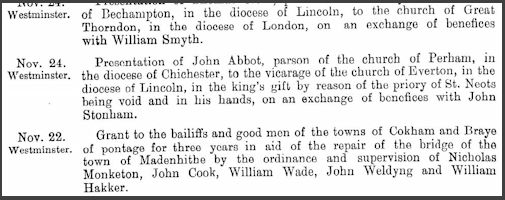Producing a pontage database
Posted on 10 September 2015
MA in Medieval History, 2015
As an optional part of my MA Medieval History course, I undertook a summer internship project with IPUP under the supervision of Professor Mark Ormrod of the Department of History, and Dr Lihua Peng, a visiting academic from Hunan Normal University, China.
The project brief was to collect data on ‘pontages’, a form of medieval tax which local authorities were granted to collect by the king in order to raise funds for the maintenance and construction of bridges. This would form part of Professor Ormrod and Dr Peng’s research into medieval administrative systems – in particular, it would create a bedrock of data which could be used to make comparisons between bridge-building and maintenance in fifteenth century England and in early medieval China (Dr Peng’s specialism). This information would be obtained by searching through the ‘Calendar of Patent Rolls’, an edited modern translation of the series of royal administrative documents from medieval England – primarily using the online fascimilies available at http://sdrc.lib.uiowa.edu/patentrolls/search.html, but also using the printed copies held in the University library for entries which have been poorly digitised or not available online at all.
The first step was to identify the information which needed to be collected, and begin to familiarise myself with the sources. From this, I created a database in Microsoft Excel into which I would enter the pontage data. This involved a degree of forward-thinking – I needed to make sure that the data could be standardised as much as possible, to ensure ease of sorting and searching when using the finished product.
Then came the data collection. Initially, I was tasked with simply recording all instances from 1400 to1500, as this is the focus of Professor Ormrod’s research. The work at this stage involved consulting the index of the Rolls for ‘pontage’, searching for the entries, and combing for relevant key information such as ‘location of bridge for which the grant is being made’, ‘name of the grant recipient’, and ‘name of the tax collector’.
As it became apparent that the majority of pontage activity had already ceased by 1400, it was agreed by the team that we would expand the focus of our activities to encompass the entire history of pontage, roughly 1200 to 1500. To carry out this task, I was aided by the work of Dr John Cooper, who had already compiled a database of pontage for 1200 to 1400. However, Dr Cooper’s database was limited in the data it contained, and so my new task was to go through the earlier Rolls and expand upon the information he had obtained. This was a lengthy task – the pre-1400 Rolls contained around 350 entries of pontage as opposed to the less than 80 or so in the fifteenth century.
After all the pontage data had been collected, the next stage was to clean up the data. It was vital to be able to locate all the instances of pontage to modern locations, and therefore I was tasked with pinpointing the modern equivalents to all places mentioned in the Rolls. This involved a certain degree of imagination and inventiveness, not to mention research skills (for instance, working out that a reference to ‘Stanys’ in fact meant the town of Staines-on-Thames!). Lastly, I mapped all the places where pontage had been collected onto a Google map of England in order to represent the data spatially.
This project was extremely enjoyable, as it gave me a chance to sample administrative history, which is a field that I had not previously given much consideration. In using the Patent Rolls, I have found a potentially useful source for future PhD research. Moreover, it gave me experience of academic collaboration, in working with Professor Ormrod and Dr Peng in order to combine our separate research experiences towards a single cause. Lastly, though data handling may not sound exciting at first, there is a surprising amount of humour that one can find in the Patent Rolls! For instance, I discovered that the tax collectors for Maidenhead in 1398 were Messers John Baker and John Cake, which lead me to wonder if the Victorian editors of the Rolls perhaps were a little hungry when they translated that passage…

Image: Example of a patent roll entry
